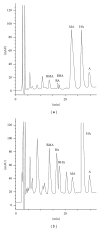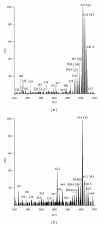Quantitative and Qualitative Analysis of Aconitum Alkaloids in Raw and Processed Chuanwu and Caowu by HPLC in Combination with Automated Analytical System and ESI/MS/MS
- PMID: 22567575
- PMCID: PMC3335326
- DOI: 10.1155/2012/936131
Quantitative and Qualitative Analysis of Aconitum Alkaloids in Raw and Processed Chuanwu and Caowu by HPLC in Combination with Automated Analytical System and ESI/MS/MS
Abstract
HPLC in combination with automated analytical system and ESI/MS/MS was used to analyze aconitine (A), mesaconitine (MA), hypaconitine (HA), and their benzoyl analogs in the Chinese herbs Caowu and Chuanwu. First, an HPLC method was developed and validated to determine A, MA, and HA in raw and processed Caowu and Chuanwu. Then an automated analytical system and ESI/MS/MS were applied to analyze these alkaloids and their semihydrolyzed products. The results obtained from automated analytical system are identical to those from ESI/MS/MS, which indicated that the method is a convenient and rapid tool for the qualitative analysis of herbal preparations. Furthermore, HA was little hydrolyzed by heating processes and thus it might account more for the toxicity of processed aconites. Hence, HA could be used as an indicator when one alkaloid is required as a reference to monitor the quality of raw and processed Chuanwu and Caowu. In addition, the raw and processed Chuanwu and Caowu can be distinguished by monitoring the ratio of A and MA to HA.
Figures





References
-
- Hikino H, Murakami M, Konno C, Watanabe H. Determination of aconitine alkaloids in Aconitum roots. Planta Medica. 1983;48(2):67–71. - PubMed
-
- Bello-Ramirez AM, Nava-Ocampo AA. A QSAR analysis of toxicity of Aconitum alkaloids. Fundamental and Clinical Pharmacology. 2004;18:699–704. - PubMed
-
- Chan TYK. Aconite poisoning. Clinical Toxicology. 2009;47(4):279–285. - PubMed
-
- Poon WT, Lai CK, Ching CK, et al. Aconite poisoning in camouflage. Hong Kong Medical Journal. 2006;12(6):456–459. - PubMed
-
- But PPH, Tai YT, Young K. Three fatal cases of herbal aconite poisoning. Veterinary and Human Toxicology. 1994;36(3):212–215. - PubMed
LinkOut - more resources
Full Text Sources
Other Literature Sources

